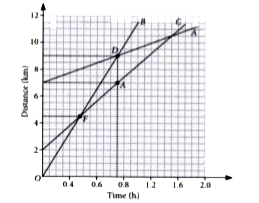Which of the following is true for displacement ?
(a) It cannot be zero.
(b) Its magnitude is greater than the distance travelled by the object.
Step by step video & image solution for Which of the following is true for displacement ? (a) It cannot be zero. (b) Its magnitude is greater than the distance travelled by the object. by Physics experts to help you in doubts & scoring excellent marks in Class 9 exams.
Updated on:21/07/2023Topper's Solved these Questions
Similar Questions
Knowledge Check
Which of the following cannot displace hydrogen from steam ?
ACdBFeCCrDZnWhich of the following cannot travel through Vacuum?
ALight wavesBHeat wavesCX - raysDSound wavesWhich of the following cannot travel through Vacuum?
ALight wavesBHeat wavesCX-raysDSound waves
Can displacement be greater than distance?
View SolutionWhen a particle is undergoing motion, the diplacement of the particle has a magnitude that is equal to or smaller than the total distance travelled by the particle. In many cases the displacement of the particle may actually be zero, while the distance travelled by it is non-zero. Both these quantities, however depend on the frame of reference in which motion of the particle is being observed. Consider a particle which is projected in the earth's gravitational field, close to its surface, with a speed of 100√2m/s, at an angle of 45∘ with the horizontal in the eastward direction. Ignore air resistance and assume that the acceleration due to gravity is 10m/s2.
There exists a frame (D) in which the distance travelled by the particle is minimum. This minimum distance is equal to :-
View SolutionGiven figure shows the distance - time graph of three object A, B and C as time is taken on x- axis and distance is taken on y - axis . The slope of the distance - time graph of an object represents its speed .
The magnitude of displacement equal to the distance travelled by the object , then we can use the term uniform velocity in place of uniform speed

Which pair out of the three objects A, B and C travelled equal distance at any point ?
View SolutionWhich of the following has ΔS∘ greater than zero
View SolutionGiven figure shows the distance - time graph of three object A, B and C as time is taken on x- axis and distance is taken on y - axis . The slope of the distance - time graph of an object represents its speed .
The magnitude of displacement equal to the distance travelled by the object , then we can use the term uniform velocity in place of uniform speed

When B passes a distnace travelled by C is
View Solution